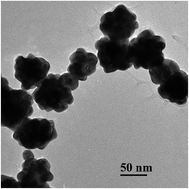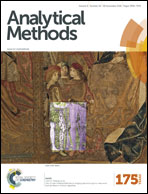A chemiluminescent aptasensor for simultaneous detection of three antibiotics in milk†
Abstract
In this study, a highly sensitive and specific multiplex chemiluminescent method for the simultaneous detection of three antibiotics was fabricated. Thiolated hybridized complementary strand (cDNA) modified N-(4-aminobutyl)-N-ethylisoluminol (ABEI) functionalized flowerlike gold nanostructures (AuNFs) were used as signal probes. Oxytetracycline (OTC), tetracycline (TET) and kanamycin (Kana) aptamers that were fixed onto the bottom of microtiter plates were used as recognition molecules. Targets and signal probes can competitively combine with the fixed aptamers. Thus, OTC, TET and Kana can be simultaneously detected based on an ABEI–H2O2–P-iodophenol (PIP) steady-state chemiluminescence (CL) system and the CL intensity is related to the negative logarithm of the concentrations of OTC/TET/Kana, respectively. The ranges are 0.05 to 5 ng mL−1, 0.05 to 5 ng mL−1, and 0.005 to 0.5 ng mL−1, and the detection limits are 0.02, 0.02 and 0.002 ng mL−1 (S/N = 3), respectively. The capability of the bioassay in milk was also studied using the standard addition recovery method, and the results showed a good consistency with the ones that were obtained from a commercial ELISA method. Owing to the advantages of a simple operation procedure, and excellent selectivity and specificity, the proposed biosensor demonstrated great potential in the application of food safety and multiplex nanosensors.


 Please wait while we load your content...
Please wait while we load your content...